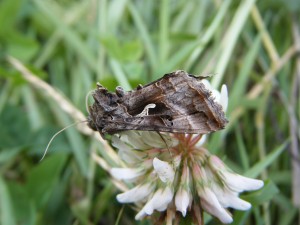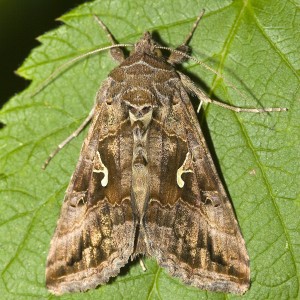Summer is upon us (we hope) and signs have been emerging despite the weather. Today, whilst in the Harris Garden apart from the bees buzzing, the Silver Y moth (Autographa gamma), a regular immigrant to the UK, was extremely common in the long grass areas. In just 20 minutes I counted 10 individuals, making quick jets of movement within the grass. The species has also been recorded before on campus, through the Rothamsted trap in 1976-1977, and other observations, so it’s definitely a moth to look out for in any of the long grass areas, with good nectar sources.
This species is both day and night flying, being one of the most regular migrants from the continent into the UK, see image 1. It is also a large moth with a wingspan up to 45mm.
The species, as an adult, can feed and will hover using it proboscis to harvest nectar. The species can be found throughout the UK, migrating using warm southerly winds, with the species being found through Europe, parts of Asia and North Africa. The species feeds on a wide range of species as larvae (polyphagous), including many commercial crops such as cabbages (Brassica sp.) and peas (Pisum sp.) etc but also uses common “weeds” like Common Nettle (Urtica dioica). The density of individuals, may have been a result of the spectacular Vipers Bugloss (Echium vulgare) display in the Harris Garden. Unfortunately for the Silver Y, it is usually unable to survive a UK winter. The species can also breed on migrating to the UK and can have several generations if migrants are early. It is also known that the species can migrate back south. The caterpillars are a translucent green, with a white-pale yellow stripe running along the body, the species is not gregarious.
The identification of this species when it stops…. is quiet easy, even if it sits on the vegetation continuously moving the wings to keep the flight muscles warm. This is because the wings have a prominent white-silvery coloured Y marking on each wing, against a cryptic and somewhat variable background, of shades of: Buff, Light brown, Browns, Olive greens, Orange, Black, Grey/grey blue, see image 2.
We thank photographer Olaf Leillinger for permission to his image. Individual credits are given with each image.


